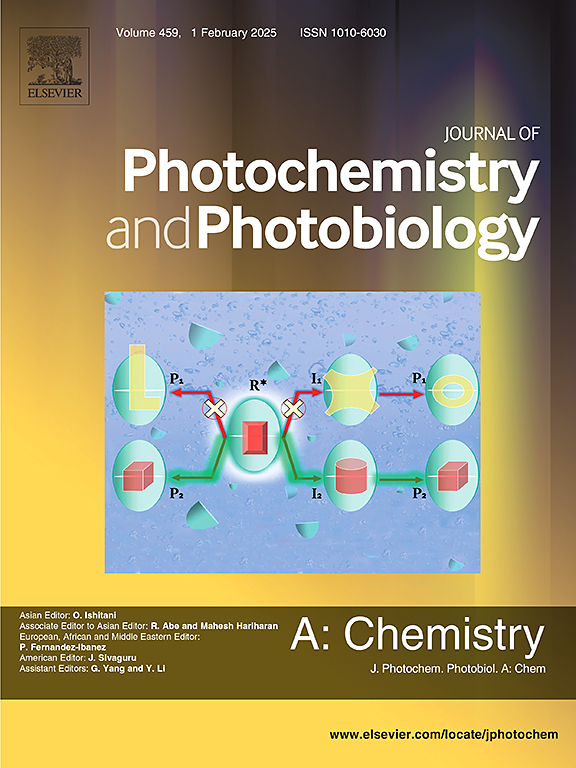Sustainable ammonia-driven large-scale synthesis of low-defect poly(heptazine imide) for boosted photocatalytic hydrogen evolution
IF 4.1
3区 化学
Q2 CHEMISTRY, PHYSICAL
Journal of Photochemistry and Photobiology A-chemistry
Pub Date : 2025-06-28
DOI:10.1016/j.jphotochem.2025.116600
引用次数: 0
Abstract
The synthesis of crystalline poly(heptazine imide) (PHI) represents a promising approach to enhance the photocatalytic activity of carbon nitride. However, achieving high yields of PHI has been a persistent challenge in the field. Herein, we introduced a novel one-step strategy for large-scale synthesis of PHI by thermal heating a mixture of melamine, KSCN and NH4Cl. Benefitting from the dual effects of the by-product precursor NH4SCN, produced from the reaction of KSCN and NH4Cl, as well as the maintenance of a sustainable NH3 atmosphere, the yields of the resultant PHIx samples can reach up to 100.5 % relative to 2 g of melamine. Among these samples, PHI2 stands out due to its superior crystallinity and minimal defect density compared to conventional PHI. As a result, the photocatalytic H2 evolution reaction (HER) rate of PHI2 is 7.0 times than that of PHI. Furthermore, PHI2 demonstrates an exceptional apparent quantum efficiency (AQE) of 30.7 % at a wavelength of 420 nm. The enhanced HER rate and AQE of PHI2 are attributed to the reduced defect density in its conjugated heptazine skeleton, which facilitates efficient charge carrier separation and transfer. This work not only achieves high-yield production of PHI but also paves the way for the large-scale application of carbon nitride photocatalysts.

可持续氨驱动大规模合成低缺陷聚七嗪亚胺促进光催化析氢
结晶聚七嗪亚胺(PHI)的合成是提高氮化碳光催化活性的一种很有前途的方法。然而,实现高产量的PHI一直是该领域的一个挑战。在此,我们介绍了一种通过加热三聚氰胺,KSCN和NH4Cl的混合物来大规模合成PHI的新一步策略。得益于KSCN和NH4Cl反应产生的副产物前体NH4SCN的双重作用,以及维持可持续的NH3气氛,所得PHIx样品的产率相对于2 g三聚氰胺可达100.5%。在这些样品中,与传统的PHI相比,PHI2因其优异的结晶度和最小的缺陷密度而脱颖而出。结果表明,PHI2的光催化析氢反应速率(HER)是PHI的7.0倍。此外,PHI2在420 nm波长处表现出30.7%的表观量子效率(AQE)。PHI2的HER率和AQE的提高是由于其共轭七嗪骨架的缺陷密度降低,有利于有效的载子分离和转移。这项工作不仅实现了PHI的高产产,而且为氮化碳光催化剂的大规模应用铺平了道路。
本文章由计算机程序翻译,如有差异,请以英文原文为准。
求助全文
约1分钟内获得全文
求助全文
来源期刊
CiteScore
7.90
自引率
7.00%
发文量
580
审稿时长
48 days
期刊介绍:
JPPA publishes the results of fundamental studies on all aspects of chemical phenomena induced by interactions between light and molecules/matter of all kinds.
All systems capable of being described at the molecular or integrated multimolecular level are appropriate for the journal. This includes all molecular chemical species as well as biomolecular, supramolecular, polymer and other macromolecular systems, as well as solid state photochemistry. In addition, the journal publishes studies of semiconductor and other photoactive organic and inorganic materials, photocatalysis (organic, inorganic, supramolecular and superconductor).
The scope includes condensed and gas phase photochemistry, as well as synchrotron radiation chemistry. A broad range of processes and techniques in photochemistry are covered such as light induced energy, electron and proton transfer; nonlinear photochemical behavior; mechanistic investigation of photochemical reactions and identification of the products of photochemical reactions; quantum yield determinations and measurements of rate constants for primary and secondary photochemical processes; steady-state and time-resolved emission, ultrafast spectroscopic methods, single molecule spectroscopy, time resolved X-ray diffraction, luminescence microscopy, and scattering spectroscopy applied to photochemistry. Papers in emerging and applied areas such as luminescent sensors, electroluminescence, solar energy conversion, atmospheric photochemistry, environmental remediation, and related photocatalytic chemistry are also welcome.

 求助内容:
求助内容: 应助结果提醒方式:
应助结果提醒方式:


